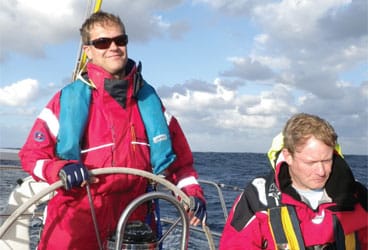
Sailing in Safety Gear
Though I spend most of my time fiddling around with a variety of cruising sailboats, for the pure joy of trimming in a sail and scooting across the water, I’ll take a little boat any day. They keep you focused, your thoughts in the moment. With no lumps of lead hanging in the water, weight and balance can’t be afterthoughts. Without an engine, every approach to a dock or beach can be an adventure. In a low-slung dinghy, you soon learn that under way, you keep one hand on the tiller and one on the mainsheet, or you’re bound to get wet. In a small boat in any sort of breeze—except, perhaps, on a Laser or some other sled designed to crash and burn—safety is always a top-of-mind concern as you crouch and duck to avoid the boom with every tack and jibe. Drift off for a minute and the rush of water over the gunwale will bring you back in a hurry.
Earlier this fall, when a bunch of us set off one afternoon for a small-craft adventure, I noticed that all my mates, few of whom would ever think to don a life jacket on a bigger boat, were safely zipped into sports vests, ready to float should a gust upset things. I don’t mention this with the intention of going on some rant about how there should be a law that all of us must wear a PFD every time we’re within a stone’s throw of the water. No, I bring this up to point out that on the water, safety is a moving target of sorts, and the prudent skipper will assess the surroundings and act accordingly.
On my big boat, for instance, when dense fog rolls in, out comes the air horn and on go the life jackets. If I’m not alone, I’ll ask someone aboard to sit forward of the mast as a lookout, and we’ll keep conversation to a minimum. The thought of being broadsided by some yahoo in a lobster yacht barreling along at full throttle, fully trusting his radar and chart plotter, gives me the creeps.
Weather, crew experience, the condition of the boat—all these factor in when deciding what safety measures are necessary. We don’t need more regulations to keep us from harm on the water; we need responsible skippers who are vigilant and who prefer to err on the side of precaution.
This fall, CW ran a contest asking readers to send in accounts of times when their safety-at-sea knowledge was put to a test. (Three winners will be announced in our November 8 e-newsletter, CW Reckonings.) Reading through some of the early entries, I was struck both by the variety of experiences and by what each sailor deemed a challenge. For some, it was leaving the sight of land for the first time; others told of truly harrowing storm conditions. What each had in common, though, was the fact that someone on board acted prudently when the writers found themselves pushed beyond their comfort levels.
To steal a line from back then, if it feels good, do it. Or to put it another way, if something doesn’t feel right, don’t wait until disaster strikes to take action. Safety is a state of mind, so listen to yours, and don’t let someone else on board talk you out of it.
Mark Pillsbury







